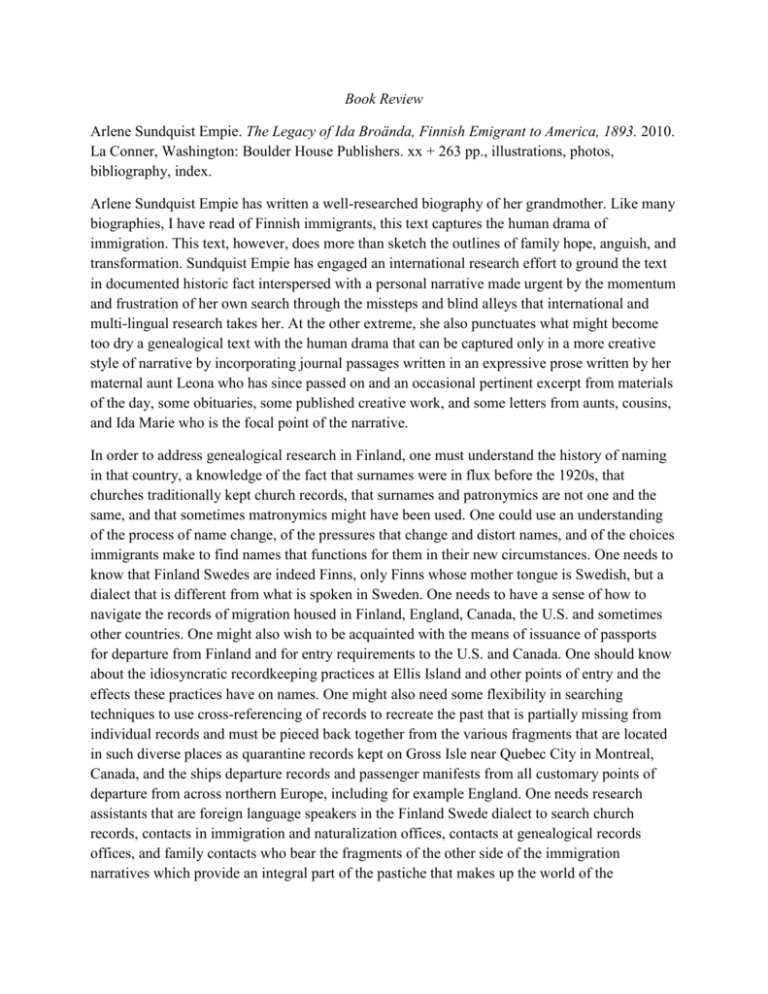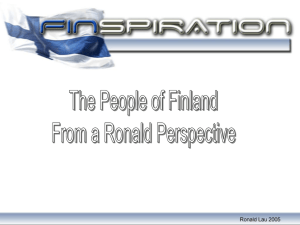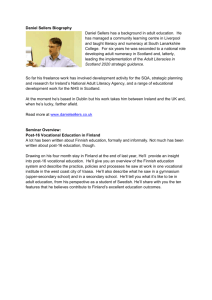here
advertisement

Book Review Arlene Sundquist Empie. The Legacy of Ida Broända, Finnish Emigrant to America, 1893. 2010. La Conner, Washington: Boulder House Publishers. xx + 263 pp., illustrations, photos, bibliography, index. Arlene Sundquist Empie has written a well-researched biography of her grandmother. Like many biographies, I have read of Finnish immigrants, this text captures the human drama of immigration. This text, however, does more than sketch the outlines of family hope, anguish, and transformation. Sundquist Empie has engaged an international research effort to ground the text in documented historic fact interspersed with a personal narrative made urgent by the momentum and frustration of her own search through the missteps and blind alleys that international and multi-lingual research takes her. At the other extreme, she also punctuates what might become too dry a genealogical text with the human drama that can be captured only in a more creative style of narrative by incorporating journal passages written in an expressive prose written by her maternal aunt Leona who has since passed on and an occasional pertinent excerpt from materials of the day, some obituaries, some published creative work, and some letters from aunts, cousins, and Ida Marie who is the focal point of the narrative. In order to address genealogical research in Finland, one must understand the history of naming in that country, a knowledge of the fact that surnames were in flux before the 1920s, that churches traditionally kept church records, that surnames and patronymics are not one and the same, and that sometimes matronymics might have been used. One could use an understanding of the process of name change, of the pressures that change and distort names, and of the choices immigrants make to find names that functions for them in their new circumstances. One needs to know that Finland Swedes are indeed Finns, only Finns whose mother tongue is Swedish, but a dialect that is different from what is spoken in Sweden. One needs to have a sense of how to navigate the records of migration housed in Finland, England, Canada, the U.S. and sometimes other countries. One might also wish to be acquainted with the means of issuance of passports for departure from Finland and for entry requirements to the U.S. and Canada. One should know about the idiosyncratic recordkeeping practices at Ellis Island and other points of entry and the effects these practices have on names. One might also need some flexibility in searching techniques to use cross-referencing of records to recreate the past that is partially missing from individual records and must be pieced back together from the various fragments that are located in such diverse places as quarantine records kept on Gross Isle near Quebec City in Montreal, Canada, and the ships departure records and passenger manifests from all customary points of departure from across northern Europe, including for example England. One needs research assistants that are foreign language speakers in the Finland Swede dialect to search church records, contacts in immigration and naturalization offices, contacts at genealogical records offices, and family contacts who bear the fragments of the other side of the immigration narratives which provide an integral part of the pastiche that makes up the world of the immigrant. Sundquist Empie brings to bear all of these resources into a compelling story through which we uncover the life of Ida Marie Andersson Lillbroända Sundquist. The story here is told large. We learn of Ida Marie, her parents, her husband, his parents, their region in Finland, the progress of their lives, their challenges and losses, and the context of their linguistic world at the start and at the end of the story. We learn about the children John Sundquist and Ida Marie Sundquist bear together, the ones who live and the ones who die. We learn in human terms what the American Dream really looks like, and it is not a dream without pain. It is, though, a success story that starts with a family in a small, rural community in Finland. The family grows across an ocean and passes through several states and three generations to end up in Skagit Valley, Washington, where a farm built and children learn to become at home in English, where high school graduation is taken for granted and college degrees become parts of family accomplishments, where professors and writers of triumphant stories can see from here clear back to their roots in the Finnish archipelago. This book is augmented with several illustrations, includes acknowledgements and a foreword that discusses both the source material from the author’s aunt Leona and the author’s own work, and documents fully the research in a bibliography. It also contains a detailed index.








